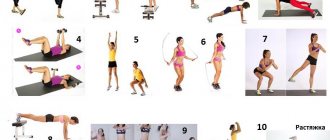The Myth That Workouts Must Constantly Change
Concepts like “change up often” are nothing more than a stupid myth designed to get you to buy as many sports magazines as possible (“Varying up your workouts is important, so buy the next issue where we’ll publish an even better workout for you”).
Of course, it is true that over time your body adapts to the pattern in which you exercise, and the results are no longer obvious. However, you do not need to change the program, but adjust the load.
Your body doesn't care which way the muscle is worked, through exercise A or B. The muscle simply feels the tension, and if it increases over time (due to changes in reps/weight lifted), the body will begin to adapt by making the necessary changes (increasing muscle mass, increasing strength, and so on).
And if you constantly change your program, it will be difficult to progress, since the load in this case occurs first on one muscle, then on another.
Therefore, in training it is recommended to use the principle “don’t change anything as long as it works.”
Analysis of load progression
Muscles are a complex of tissues in our body, the characteristic feature of which is the ABILITY TO CONTRACT. There are 640 of them in our body.
They are designed for a variety of actions: for body movement (flexion and extension of joints, movement of bones relative to each other, etc.), contraction of the vocal cords (due to which we speak), breathing.
Muscles can become fatigued under intense exercise and CONTRACT under the influence of nerve impulses.
Muscles grow under the influence of GROWING (progressive load).
This is just an adaptation mechanism for a certain type of physical activity.
The body resists heavy lifting and responds by growing muscle to make similar lifting easier to do in the future.
On this occasion, I have written a cool article about supercompensation.
Training volume increases = Muscles grow.
That is why we need to ensure a constant increase in external load. So that the body begins to adapt to it and responds to this with muscle growth.
You can increase the load in many ways, but the most common ones are:
- Increase in working scales.
- Increasing the number of working approaches and repetitions, exercises.
- Super moves.
As the working weights increase, it is clear that the weight on the bar increases = the training load increases.
This is the most obvious, but not the only way.
"Jumpers"
In addition to people who adjust their training patterns too often, there is another group of people who can be called "jumpers."
These are people who “jump” from one program to another because they believe that the new one will definitely be better than the previous one. They go to one training session, hoping to get instant results, and after a couple of sessions they take on another program, thinking that it will definitely help from the first session.
Such misconceptions have taken root very well in our heads. Hundreds of fitness magazines, websites and forums constantly publish thousands of "even better" workouts to keep you doubtful and eager to buy a new issue or renew your subscription. They claim that your program, which you started a week ago, is much worse than the new and amazingly effective one they will publish tomorrow.
And so every day/week/month you experience this pressure. This is important for magazines: they increase their sales. But, unfortunately, this will not bring you results. In fact, no program will work unless you practice it for a long time.
Levels of training
Experts advise remembering that training changes occur based on the level of preparedness:
- Beginners. The program is changed at 10-16 weeks, or after 2.5-4.5 months.
- Average level. Optimal period: 8-11 weeks, or 2-3 months.
- Advanced. The change occurs at 4-6 weeks, or after a month and a half.
Thus, before starting the transition to a new program, it is worth understanding the level of preparation. If training began not so long ago, the body is not yet ready to change the program, and changing the program too quickly can cause harm.
When should you change your training program?
But the program is still worth changing. And not in the case when you worked out on it for N weeks, or when you suddenly decided “well, it’s time to surprise my muscles with something new,” or when your magazine offered you a new miraculously effective complex. This should only happen when you have a legal reason to do so.
Reasons for changing the program
- If your program has not been producing results for a long time. This is truly the #1 reason to change up your regular workout routine. The main thing here is to soberly assess: whether I have set unrealistic goals for myself with too short a waiting period.
- If you are bored to death doing the same exercises. In this case, your motivation to go to the gym will weaken, so in order to awaken interest again, the training program should be adjusted (here, again, you need to remain realistic and not start to “get bored” of the program after a week or two).
- If the goal has changed. For example, your goal was to increase strength, but now you want to build muscle or lose weight. In this case, changes to the program must, of course, be made.
- If you are affected by external force majeure circumstances, for example, changes in your daily schedule do not allow you to train according to your old schedule. Or you have an injury that prevents you from performing any exercises.
These are actually the four reasons when your usual training pattern can be changed.
If necessary?
In addition, few people know, but each exercise has its own system of neuromuscular adaptation. Those. The body adapts to each exercise in its own way. Look at how beginners squat (even without weight): their legs tremble, their backs bend, their knees tend to move together. And this is not because their body structure is different from the jocks in the gym. No, their muscles just “don’t know how” to squat!
The training period can take from several weeks to several months depending on the complexity of the exercise . To make it clearer what we are talking about, compare two exercises according to the degree of their mastery - biceps curls and deadlifts . The first one is learned quickly, the second one takes much longer.
So, according to the theory of neuromuscular adaptation, muscle growth at the initial stage, when the body becomes familiar with a new exercise, is minimal. A serious increase in muscle size occurs only after overcoming the “neural plateau” (neural changes plateau).
Look at the graph of the study “Neural adaptation to resistance training” (Med Sci Sports Exerc. 1988). It clearly shows that at first (8-20 weeks) neural (neuromuscular) changes occur in the body and after this period more noticeable muscle growth is observed.
The increase in peak strength and the rate of its increase are associated with an increase in the ability of the nervous system to activate an increasing number of muscle fibers during exercise. Strength training can induce adaptive changes in the nervous system that allow exercisers to more fully activate the primary driving forces in certain movements and better coordinate the recruitment of all relevant muscles, thereby providing greater net force in a given direction of movement. The increase in strength occurs primarily through improved neural adaptation skill rather than through muscle growth .
So stop trying to diversify the program: believe me, working with different weights is quite enough to surprise your muscles. Well, think for yourself, according to this logic, we should abandon basic exercises, “after all, muscles can no longer be surprised by them,” however, there are thousands of examples where people doing only basic exercises for many years grow and remain in great shape. But those who rush from exercise to exercise like a mad flea remain practically in the form with which they began their training.
Few people know about this, but if you do the same exercise not for 6 months, but for several years, then it becomes not just habitual, but familiar, loved, and brings colossal results. Imagine how you will practice your technique in it during this period!
Of course, there is one caveat. It is difficult to train for a long time if the exercise quickly gets boring. Therefore, you can add new isolation exercises for variety. Just never touch the base ! This is your foundation, your bread.
Let's give an example-analogy. American scientists tried to understand what to feed soldiers during the war. In war, soldiers quickly lose weight; it is difficult to force them to eat at all. They were given everything in their travel rations: Mexican cuisine, Italian and other delicacies. At first, the soldiers liked to eat unusual foods. But! Then she quickly got bored. The only thing I didn't get tired of was the bread. All soldiers could eat bread all the time.
Do new exercises “surprise” your muscles? This is true. But! New exercises quickly become boring, and muscles do not grow without well-formed motor skills . A well-formed motor skill is everyday bread, it’s a habit, it’s a favorite exercise. This is a movement ingrained in the memory of the spinal cord. This is what makes muscles grow.
The only thing the muscles respond to is progressive overload , that is, gradually increasing the weights and/or repetitions of a particular exercise over time and periodizing them. You must constantly load your muscles a little more than what they are used to. This is the only way muscles grow. And unlike “muscle surprise,” it’s scientifically proven. Plus, training in the style of taking one step back (controlled relaxation) in order to take two steps forward (controlled stress) will bring you progress and save you from fatigue and injury.
Therefore, all this “pumped up her 100 cm butt with a 20 kg squat and butt swings with weights” is a lie and a provocation: take this lady to an ultrasound of her Madame Sizha, as if you will find something “foreign” there. Butt without squats: is it possible?
Don't worry that monotony will eat you up. Imagine: today we press 50X6/4 (6 reps, 4 sets), next time 50X6/6, then 50X6/8, then 50X8/4, then 50X8/6, at the next workout 50X8/8 - there’s already variety, not a single workout is similar to another. If you want to increase a specific muscle, you don't have to do dozens of different exercises from workout to workout. You need to choose a few exercises and increase the weight and/or repetitions from time to time.
Understand that changing exercises will not speed up your transformation from scumbag to Greek god. Nature does not agree to change you in a few months: burn fat, build muscles, and make your hair thicker. It is more correct to think in terms of “ evolution of the body .” The word “evolution” should be understood as many years of experience.
By the way, many still believe that pain the day after training indicates good work and that you have surprised the muscles enough for their growth. And if suddenly nothing hurts in the morning, something was wrong in the training. Pain is not a sign of muscle growth . It means that your body did something that it is not used to doing, the muscles are in some sense “surprised”, but there is no direct connection with growth.
If you change exercises every 4-6 weeks, then the body will not have time to build a good brain-muscle connection , which is involved in a particular exercise. Think for yourself: the body will only manage to set up this connection, and you will already be jumping to another exercise (training program).
To improve neuromuscular communication, your training program should always include multi-joint exercises for each muscle group. In this case, the neuromuscular connection develops faster than if the training program included only single-joint movements.
How to change the program?
In most cases, it is necessary to maintain the general structure of the workout and replace only a few exercises in it.
For example, if you do split squats, you can do lunges with dumbbells. If you're doing any "bilateral exercises" (that is, using both arms or legs at the same time), switch to unilateral loads (where each arm or leg works separately). If you do inclines with dumbbells, replace them with inclines with a barbell. And so on.
More often than not, these small changes are effective, which is why they are the most popular. Simply replace some exercises with similar ones or others, but aimed at the same target muscle groups.
Additionally, there are many other changes that can be made without changing the program itself. For example, if you work out four times a week, you can change the order of your workouts: start the week with a lower body workout instead of the upper body as usual. Or change the number of sets or reps. If you did three sets of eight reps (for a total of 24 reps), do four sets of six reps (that leaves a total of 24 reps). And so on.
How often should I make changes?
At this point you usually want to hear something like: “You should change the program every N weeks,” but, alas, there is no such formula. Because your program can work for results for two weeks, or four, or eight, or for the rest of your life - you can’t predict it.
Of course, there are situations when you should abandon a program completely and take on another.
But if everything is working, and you don’t have any of the reasons we’ve listed to change anything, leave everything as it is. Corporate fitness is a good motivation for employees of any company. Many clubs in different cities provide this opportunity. Here, for example, is one of the programs in Moscow - https://sante-fitness.ru/uslugi/korporativnyy-fitnes/.











